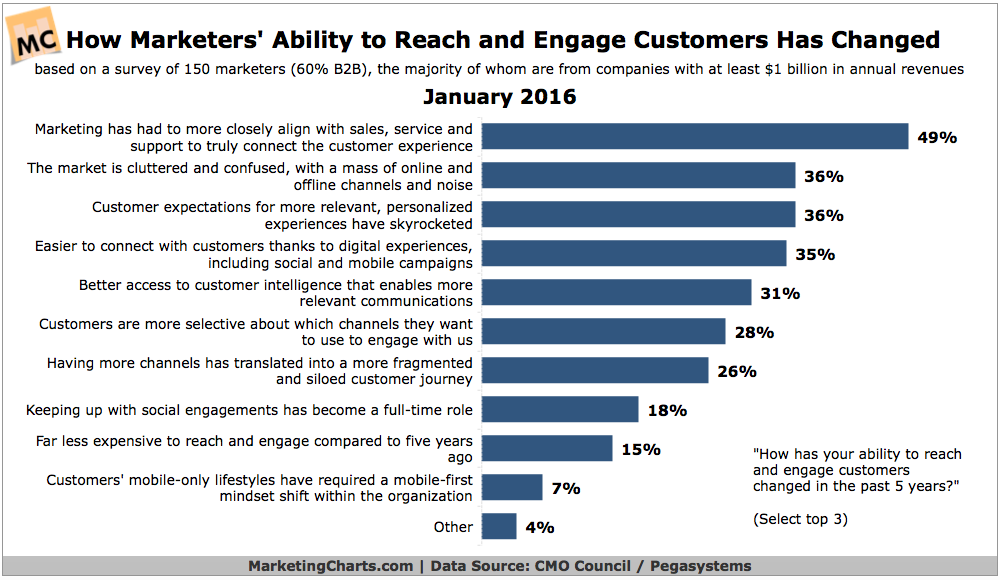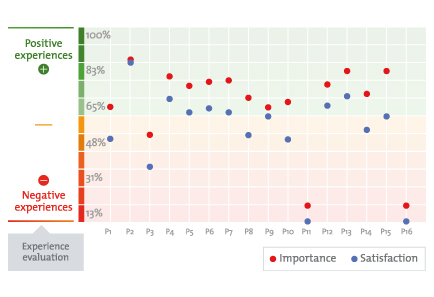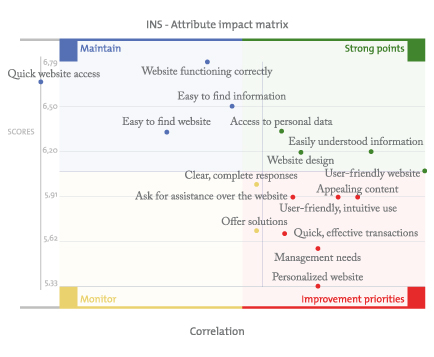KISSmetrics: The Evolution of Customer Engagement (And How It’s Changing Everything)
KISSmetrics: The Evolution of Customer Engagement (And How It’s Changing Everything) |
| The Evolution of Customer Engagement (And How It’s Changing Everything) Posted: 07 Mar 2016 09:53 AM PST How do you measure customer engagement? If you're like most marketers, it's all about the revenue. And while revenue is important, much of what we think about customer engagement is changing considerably. For example, according to a recent report by eMarketer, most executives look at metrics like clicks, conversions, shares and traffic as prime indicators – but these metrics can't really measure engagement per se and nor can they measure a customer's satisfaction with the service they received. In fact, just look at how marketers view the shifting customer service landscape:
Nearly half of those surveyed felt that they needed to better align with sales and support to deliver a complete customer experience. But how exactly do you do this? Looking at three of the more considerable metrics on the chart above reveals some insights when it comes to personalization, filtering and what information is collected about customers (and what information they choose to share). The Signal-to-Noise RatioIt's evident from the graphic that customers are now available and open to receiving information than ever before. But for the uninitiated company, this doesn't mean simply "throw out all the advertising you can at them and hope some of it sticks." People are tired of being marketed to like brainless zombies, and instead want their business to be valued. They want to share their experiences with friends on social media and rave about the latest deals or what fantastic service they got. BUT – and this is a big one – customers don't want to be babysat. They don't want to be reminded for the umpteenth time to leave a review about the cat litter they just bought. Nor do they want to be doggedly followed from site to site showing ads for that lingerie they were looking at. They want less noise and more tailored offers, personalized to their tastes. Importance Versus SatisfactionIn customer service, a lot of effort goes into explaining (and looking for ways to create) "memorable moments". These are moments where the customer shopping experience was so good/timely/affordable that they can't help but remember it. Now, it's important to note that a customer isn't going to have a memorable experience every single time they shop. But looking at these experience (and their relative levels of importance) is a good way to set and manage customer experiences. Imagine for a moment if expectations were low, but experience was high. A customer might remember that moment, right? And conversely, if expectations were high and experience low – a customer will definitely remember it – and likely tell others. Being able to accurately pinpoint where (on the map) the customer interacts with the company and how to make these points as even as possible is the "sweet spot" every company – whether you're selling lingerie, or cat litter – needs to aim for. Physical Versus Emotional VariablesThere are a lot of core physical variables that customers look for no matter what they're buying. Things like:
These are all physical points that you can control to some extent. Interjecting emotional value into physical points broadens the overall customer experience into so much more. Love it or hate it, you know when you're entering a Hollister store. The dark lights, the music, and even the smell. That's not to say that all customer experiences should be 100% sensory only. But making them feel things in connection to shopping online (the excitement of getting a branded package from Amazon.com, for instance), greatly heightens their satisfaction and in effect, doing business with you. Tying Customer Experiences to Measurable GoalsHere's the real question: How do you measure something as intangible as customer experience? Sure, the aforementioned metrics are a good place to start, as is overall customer satisfaction levels –but they don't paint a complete picture. It's vital when considering customer experiences as a whole that you look at the areas where improvements can always be made – such as:
This marketing matrix, from the Customer Experience (Spain) shows how you can tie those improvements to overall goals to make real progress toward your customer engagement improvement initiatives. This will give you concrete milestones to work from as you keep improving your process. It won't happen overnight, but gradually, you'll be able to see impactful improvements to metrics like time-on-site, lower bounce rates, social shares and other measurable points. And if you're not getting the kind of results you'd hoped for, don't be afraid to make changes and shift with the changing customer experience tides. People are rightfully expecting a lot more out of the companies they're most loyal to, but companies aren't afraid to take some risks and step up to the place to align themselves with their customers' needs too. The bottom line is always going to be to look at what your data is telling you. Draw meaningful conclusions, but don't doggedly cling to it. We're all human, and sometimes unpredictable and wavering in what we really want from a brand. But it doesn't have to be overwhelming. In an August 2015 survey from Ovum and Opinium Research LLP, nearly 81% of the customers surveyed reported that the issue [which would give them the greatest positive experience with a brand] would be to simply have their questions answered. That's not asking for a lot, is it? They've set the bar incredibly low – presenting the perfect opportunity for smart companies to not just meet their expectations but exceed them. What Do You Think About the Shifting Customer Service Landscape?Now it's your turn. Do you feel like your company could improve on customer engagement? Or have you already made great strides and are looking to do more? Tell us about your experiences in the comments below! About the Author: Sherice Jacob helps business owners improve website design and increase conversion rates through compelling copywriting, user-friendly design and smart analytics analysis. Learn more at iElectrify.com and download your free web copy tune-up and conversion checklist. Follow @sherice on Twitter, LinkedIn or Google+ for more articles like this! |
| You are subscribed to email updates from The Kissmetrics Marketing Blog. To stop receiving these emails, you may unsubscribe now. | Email delivery powered by Google |
| Google Inc., 1600 Amphitheatre Parkway, Mountain View, CA 94043, United States | |


